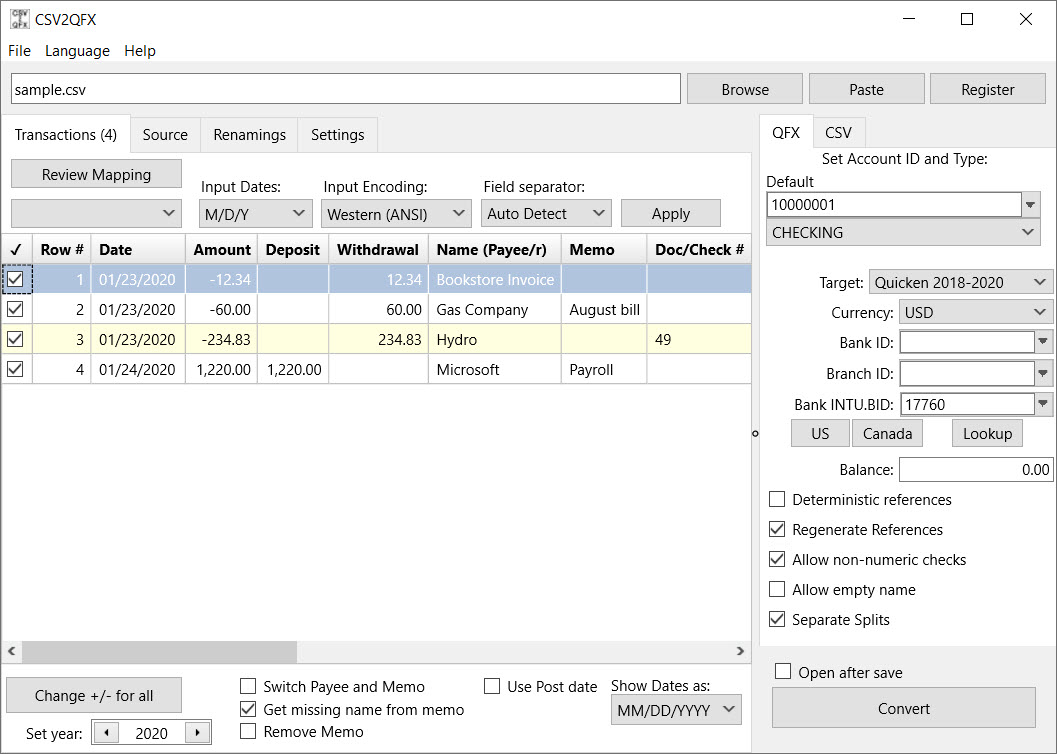

- #CONVERT MINT CSV TO QUICKEN QFX FREE HOW TO#
- #CONVERT MINT CSV TO QUICKEN QFX FREE FOR MAC#
- #CONVERT MINT CSV TO QUICKEN QFX FREE DOWNLOAD#
This tutorial shows how to convert a PDF file from your bank or credit card statement to QFX (Web Connect) and import into Quicken 2017. Review created CSV file and import it into Quickbooks Online, Xero or work with the file in Excel. Click the 'Convert' button to create a CSV file. Set 'Open after conversion' to open application handling converted files to start import right after the conversion.
#CONVERT MINT CSV TO QUICKEN QFX FREE FOR MAC#
Choose the CSV target: Regular CSV, Excel (XLS or XLSX), Quickbooks Online, Xero, Quicken for Mac (CSV Mint), POSH or copy to clipboard to be pasted into any spreadsheet software like Excel. Check that dates are correct, have the correct year, amount, withdrawals, and deposits are shown in corresponding columns.
#CONVERT MINT CSV TO QUICKEN QFX FREE DOWNLOAD#
Download it and make sure you are using the latest version of the QFX2CSV. Use ProperSoft QFX2CSV to convert QFX files to CSV or Excel format and import into Excel, Quickbooks Online, Xero. IMPORTANT: QFX2CSV is discontinued and replaced with a new Transactions app (🤍 that converts from more formats and converts to more formats.Ġ0:23 - Start QFX2CSV and select a file with transactionsĠ0:33 - Review transactions before converting This tutorial shows how to convert a QFX file from your bank or credit card statement to CSV format. Then click the 'Import' button and click 'Close'. So this way you will keep the existing account connected to online services and you don't have to connect it back later. You can import in that account, and then move transactions from that account to another account. You may choose to keep online services connected and import into a new account if you have something temporary to import. If you are disconnected from online services, that account will be shown on the list. You can select 'Create a new account' or you can select 'Link to an existing account to import transactions'. To import a QFX file, select 'File' - 'File Import' - 'Web Connect (.QFX) File', select created QFX file.

Then click 'Online Services' and click on the 'Deactivate' button. Before importing a QFX file backup your data file and make sure that the account is not connected to online services. Now the QFX file is created, let's switch to Quicken and import created QFX file. Click the 'Convert' button to create a QFX file. You can also set End balance, Bank ID, Branch ID if your accounting software requires it. And for the UK edition, GBP currency must be set. For the Canadian edition, you can use USD and CAD. Currency should be USD even for non-USD accounts for the Quicken US edition. For multiple accounts, use a different Account ID for each account. Set the Account ID (number) and the Account Type to create QFX for the right account. You have to leave it empty if your bank is not listed, so the default Wells Fargo Bank Label (3000) will be used. Make sure a bank you choose, supports the Account Type you are converting for. The INTU.BID value defines the bank label shown during import. Set INTU.BID to match your bank or keep the default value.


Select the QFX target to match your Quicken version or your accounting software: Regular QFX, Quicken 2018+, Quicken 2017, Quicken 2016, Quicken 2015, YNAB. Review transactions before converting, check that dates are correct, have the correct year, deposits, and withdrawals are assigned correctly. Download it and make sure you are using the latest version of the QIF2QFX. Use ProperSoft QIF2QFX to convert QIF files to QFX (Web Connect) format and import into Quicken (Windows or Mac). IMPORTANT: QIF2QFX is discontinued and replaced with a new Transactions app (🤍 that converts from more formats and converts to more formats.Ġ0:22 - Start QIF2QFX and select a file with transactionsĠ0:36 - Review transactions before convertingĠ1:57 - Set the Account Type and Account # (number)Ġ2:45 - Set the End Balance, Bank ID, Branch IDĠ2:59 - 'Get Memo from Name', 'Allow empty name' settingsĠ3:44 - Switch to Quicken and import a QFX fileĠ4:08 - Select the account to import data intoĠ4:54 - Backup your data before importingĠ5:35 - Review the transactions and add them to the registerĠ5:55 - Disconnect from online services before importing, import a QFX file into an existing accountĠ7:25 - Review the transactions before adding them to the register This tutorial shows how to convert a QIF file from your bank or credit card statement to QFX (Web Connect) and import into Quicken.


 0 kommentar(er)
0 kommentar(er)
